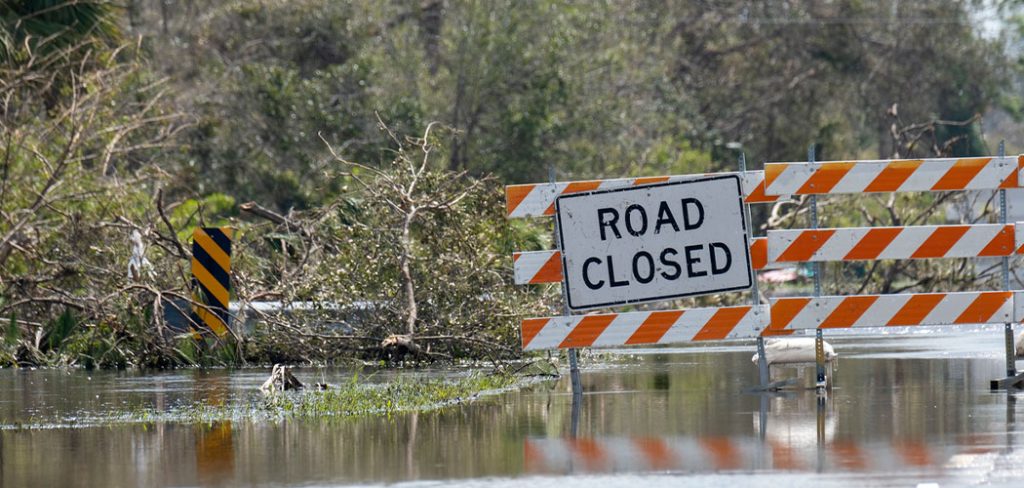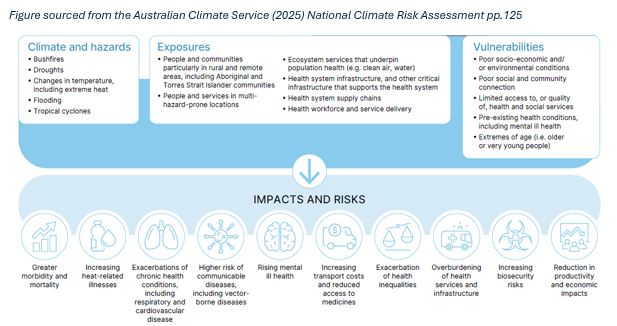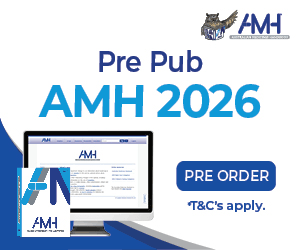Earlier this year, the Australian Nursing and Midwifery Journal published a three-part series capturing the stories of nurses, midwives and carers working on the frontline of climate-driven disasters.
These stories took readers into flood-stricken Northern New South Wales, a bushfire-surrounded hospital on the New South Wales south coast, and the heat-blasted hospital in remote Western Australia. Each of these stories highlight the resilience exhibited by nurses and midwives in responding to climate change. As the old saying goes “chop wood, carry water”, a sentiment exemplified by the resilience, courage and endurance of nurses and midwives in their communities.
This week, with the release of the National Climate Risk Assessment, it is timely to revisit these stories and place them in the broader national context.
- In Northern New South Wales, midwife Sunae Reilly improvised a clinic in a flooded school during the 2022 deluge, caring for hundreds of evacuees cut off from medical care. She organised makeshift treatment, secured oxygen and wound supplies, and arranged boat and air-drop retrievals of essential drugs. Her actions kept a community functioning amid total isolation [1].

- On Christmas Day in coastal Milton, Carolyn Antoniou was left in charge of a small hospital as bushfires closed in. With no outside support and power failing, she oversaw both the ward and emergency department, received evacuees in growing numbers, and started a backup generated to keep patients on oxygen alive [2].
- In Derby, Wendy Young endured a searing heatwave when the hospital’s cooling systems collapsed. Staff and patients sweltered in unsafe conditions as equipment failed, dialysis flights were cancelled, and mortuary refrigeration broke down. She and her colleagues laboured under unbearable strain to hold services together and support families grieving without cultural rites [3].
These are indeed stories demonstrating incredible resilience and courage but remind us of the need to invest in building a resilient health system that matches the resilience of health care workers.
National Climate Risk Assessment
On Monday, the Australian Government released the National Climate Risk Assessment [4]. The release of Australia’s first National Climate Risk Assessment confirms the climate shocks that disaster-impacted communities have been warning of and shows the need for urgent government action to ensure no one is left to shoulder these burdens alone. For health, there will be numerous climate hazards that will impact the health of communities and our patients:

The experiences recounted by Sunae, Carolyn and Wendy are not isolated occurrences. They are just the tip of an iceberg. The NCRA identifies that floods, bushfires and heatwaves are becoming more frequent and more severe as the climate warms. What nurses, midwives and carers are experiencing today is a sign of what is to come, and without intervention the scale of disruption will only intensify.
We must ask ourselves; how do we prepare our healthcare systems for these types of extreme weather events and equip clinicians to care for people at times of crisis?
Funding the National Health and Climate Strategy
Australia’s National Health and Climate Strategy, was identified in the National Adaptation Plan (also released this week), as being a key mechanism to guide the health sector response to climate change [5]. It recognises that while health workers are already showing enormous resilience, they cannot be expected to shoulder the burden alone. Yet despite its release in 2023, the strategy still lacks funding [6].
There is an urgent need to ensure hospitals and clinics can withstand floods, fires and heatwaves so staff are not left working in failing facilities. Funding the strategy will mean:
- Valuing and investing in the knowledge and leadership of health workers, particularly nurses and midwives, who have already demonstrated how to adapt in the most difficult circumstances.
- Restructuring primary and tertiary healthcare funding models to strengthen workforce mobilisation and ensure continuity of care for populations most affected by climate impacts.
- Embedding climate preparedness into undergraduate, postgraduate and continuing health education so that the next generation of professionals can step into their roles prepared to respond to the impact of for climate change.
- Investing in targeted funding for community resilience.
- Planning for medicine supply chains so communities do not go without critical treatment when disasters hit.
Additional measures Australia needs to make now
In addition to funding the National Health and Climate Strategy, we need investments in broader community adaptation and resilience. Australia needs to:
- Support communities on the frontline. Reform and grow the Disaster Ready Fund so local councils and grassroots groups can keep people safe and supported when disaster hits.
- Protect workers from climate risks. Create new workplace safety laws for extreme heat, poor air quality, and climate disasters—because everyone deserves to get home safely.
- Strengthen our homes. Build and retrofit housing so it can withstand the changing climate, keeping people safe and bills down.
- Lock in the National Adaptation Plan. Put it into law and build sector-specific pathways, like we’ve done with Net Zero. This gives investors certainty and shows where the opportunities are.
- Make finance climate smart. Expand the Sustainable Finance Taxonomy so it rewards resilience, not just emissions cuts.
Conclusion
Nurses and midwives have always ‘chopped wood and carried water’ – sustaining health through the steady, unseen work of care. But today they are carrying this ‘water’ through fire, flood, and heat. To meet these escalating threats, government investment is not optional; it is essential. The stories of Sunae, Carolyn and Wendy show that solutions do exist and that nurses and midwives are able to embrace the challenges of climate change with practical, community-led responses that keep people safe in the darkest moments. What is missing is the systemic backing to scale these solutions up. Investing in adaptation and resilience is needed so Australia can shift from patchwork crisis responses to genuine preparedness. It would give nurses, midwives and carers the support they need to keep doing what they do best: caring for their communities, no matter the circumstances.
If reading this article or the report has left you feeling worried or unsettled, please remember you’re not alone. Support is available through the Nurse & Midwife Health Program: https://nursemidwifehpa.org.au
Authors
- Catelyn Richards, ANMF (Federal Office) (Climate Change Officer, BN, M’Lship)
- Dr Aletha Ward (Chair, Planetary Health Faculty, Australian College of Nursing, RN, PhD, FACN)
- Distinguished Professor Tracy Levett-Jones (University of Technology Sydney, Lead of the Planetary Health Collaborative for Nursing & Midwives, RN, PhD, Med, BN)
References
[1] Hastie C, Ward A, Levett-Jones T. A midwife’s experience in frontline care during a flood emergency. Australia Nursing & Midwifery Journal [Internet]. 15 April 2025 [cited 2025 Sept 17]. Available from: https://anmj.org.au/a-midwifes-experience-in-frontline-care-during-a-flood-emergency/ Australian Nursing and Midwifery Journal
[2] Levett-Jones T, Ward A. Courage under fire as a nurse leads through a bushfire crisis. Australian Nursing & Midwifery Journal [Internet]. 5 May 2025 [cited 2025 Sept 17]. Available from: https://anmj.org.au/courage-under-fire-as-a-nurse-leads-through-a-bushfire-crisis/ Australian Nursing and Midwifery Journal
[3] Bonnamy J, Ward A, Levett-Jones T. A nurse’s experience managing extreme weather challenges in remote Australia. Australian Nursing & Midwifery Journal [Internet]. 15 June 2025 [cited 2025 Sept 17]. Available from: https://anmj.org.au/a-nurses-experience-managing-extreme-weather-challenges-in-remote-australia/
[4] Australian Climate Service. National Climate Risk Assessment [Internet]. Canberra: ACS; [cited 2025 Sept 17]. Available from: https://www.acs.gov.au/pages/national-climate-risk-assessment
[5] Department of Climate Change, Energy, the Environment and Water. National Adaptation Plan [Internet]. Canberra: DCCEEW; 2025 Sep 15 [cited 2025 Sep 17]. Available from: https://www.dcceew.gov.au/climate-change/publications/national-adaptation-plan
[6] Richards, C., (2025). From margins to the centre: Positioning nurses and midwives to create climate-resilient health systems. Australian Journal of Advanced Nursing, 42(2). Australian Journal of Advanced Nursing 42(2) https://doi.org/10.37464/2025.422.2282








